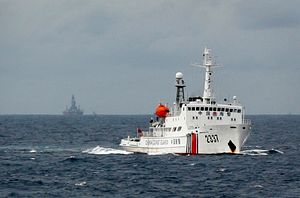Starting October 20, 2015, Vietnamese coast guard vessels will be permitted to use on-board weapons to deter and repel foreign boats. According to a report by Vietnam’s Thanh Nien news agency, the country’s government has introduced a new regulation which allows the coast guard to play a more active role in defense. The move is almost certainly a response to concerns about China’s attempts at asserting its claims to waters disputed between it and Vietnam, best encapsulated in last summer’s stand-off over China’s Haiyang Shiyou 981 oil rig, which entered Vietnam’s exclusive economic zone (EEZ). Chinese and Vietnamese vessels rammed and capsized each other at the time, and vessels from both sides exchanged water cannon fire.
The new rules could mean that should another major stand-off between China and Vietnam occur, the possibility of escalation to an all-out kinetic conflict will be much greater. Vietnam’s move also mirror’s China’s own efforts to create a “second navy” through the militarization of its white-hulled maritime law enforcement and coast guard vessels. According to Thanh Nien, the Vietnamese coast guard will be permitted to use force “until the foreign boats are completely out of Vietnamese waters.” Vietnam continues to claim the entirety of the Paracel Islands, which China administers as part of Hainan province.
It’s unclear if the new regulation distinguishes between Vietnam’s exclusive economic zone and its territorial waters–an important distinction under the United Nations Convention on the Law of the Sea (UNCLOS). According to UNCLOS, a state’s territorial sea extends out for 12 nautical miles from “baselines,” which are, with a few exceptions, defined as “low-water line along the coast as marked on large-scale charts officially recognized by the coastal State.” Meanwhile, an EEZ “is an area beyond and adjacent to the territorial sea,” extending no more than 200 nautical miles from the baselines. UNCLOS, per article 62, outlines criteria under which foreign vessels, both civilian and military, can lawfully operate within an EEZ. The Thanh Nien report is sparse on these details, noting that the new regulation applies to dealing with foreign boats that have entered “the country’s waters illegally.”
It’s unlikely that Vietnam will use this new regulation to brazenly provoke vessels lawfully operating within its EEZ, as it does not do so currently. Rather, the regulation appears to be intended to deter a repeat of last year’s oil rig saga, where Chinese civilian fishing boats and coast guard vessels, in violation of UNCLOS, were conducting activity in Vietnam’s EEZ without Hanoi’s consent. Reassuringly, the new regulation does have a warning phase–it requires that Vietnamese authorities first verbally notify foreign vessels illegally present in Vietnamese “waters” to leave the area before Vietnamese authorities are permitted to deploy offensive means to deter and repel these ships.































